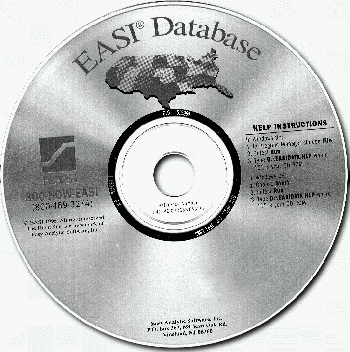Using EASI � Database Files in TNTmips� and TNTlite�
V5.50 –– October 1996

The information in EASI Database demographic files can be made available for use and viewing in TNTmips as database objects or as vector points. You can use the EASI data for pinmapping or import it as vector points because each record contains geographic coordinates. These coordinates are expressed in millionths of a degree (Latitude / Longitude). If left in database form, the EASI files can either be imported into TNTmips� database table format or linked to in their original dBASE IV format. The choice of whether to import the demographic information in the files as vector points or to leave the files in database form depends on how you intend to use the information. If you want to create pinmaps with piecharts showing the relative values of a number of fields, leave the information in database form. If you want to create theme maps without using complex queries, you need the information associated with a vector object. In addition to creating vector points with the demographic information attached, you can associate the EASI demographic data with existing vector polygon objects, such as zip code, county, or state outline maps.
Using the EASI Database demographic information in database form
There are three methods to get the EASI Database files into TNTmips: link to the database files and use them directly from the CD-ROM, import the database files as a TNTmips database object, or import the database files as points in a vector object. Each of these methods is detailed below.
To use the EASI database files directly from the CD-ROM
- Select Prepare / Import/Export / Import / Database / DBASE.
- Choose the desired source database on the EASI CD-ROM. Select a destination RVC file and object on your drive to contain the link information.
- Activate the Link option and click on the Import button.
The RVC object that contains the link information requires only about 25 K of disk space. When you want to use the database for display or other processes, select the RVC object created by the import process and the data will be read from the CD-ROM.
To import the EASI database files into RVC database format, follow steps 1�3 above except activate the Copy option rather than the Link option before clicking on the Import button. The size of the RVC object created varies with the number of records and fields in the database. Some are smaller than the object required to contain the link information, but most are significantly larger, particularly the zip code EASI Database files, which may exceed 10 Mb.
To display RVC database objects
- Launch Display / Spatial Data and choose Layer / Add / Database Pinmap. Select the database object (either imported or linked to by the import process).
- Select the object, set the X and Y coordinates to By Query and enter the
following in the Query
XCoord = TableName.LONG / 1000000
YCoord = TableName.LAT / 1000000
Include any other desired information in the query, such as drawing style (like a pie chart of income distribution for each coordinate pair). You can examine the database information as a whole or for selected points by choosing the Examine / Attributes option.
Using EASI Database demographic information with vector objects
To import the EASI database files as points in an RVC vector object
- Select Prepare / Import/Export / Import / Vector / Database.
- Choose the desired source database on the EASI CD-ROM. Select a destination RVC file and object on your drive.
- Set the Projection to Latitude / Longitude and the Coordinate Format to DDDdddddd.
- Select LONG as the X Column and LAT as the Y Column with West as the X direction and North as the Y direction. You can also opt to create a 3-D vector object and select a field such as population or quality of life to provide the Z coordinate values.
- Then click on Import. The vector object created will have as many points as there are records in the database, and the appropriate record containing all the original demographic data will be attached to each point.
To attach RVC database objects to vector polygons
- Launch Prepare / Database / Attach and select the database object (either copied or linked by the import process).
- Select the vector object with polygons for attribute attachment and set the Element Type option menu to Polygon.
- Select LONG as the X Field and LAT as the Y Field with West as the X direction and North as the Y direction.
- Set the Projection to Latitude / Longitude and the adjacent option button to DDDdddddd. Then click on Run.
To use relational database features for vector polygons with established database information
- Copy the imported or linked database to the polygon database of the desired vector object (Prepare / Database / Copy).
- Make sure a shared attribute, such as state name for a state outline map, is set as the primary key in a table with direct attachments to the polygons.
- Edit the table definition for the EASI table and use the Primary Key option button to select the related key field. Also set the Attachment Type option button to Related Only.